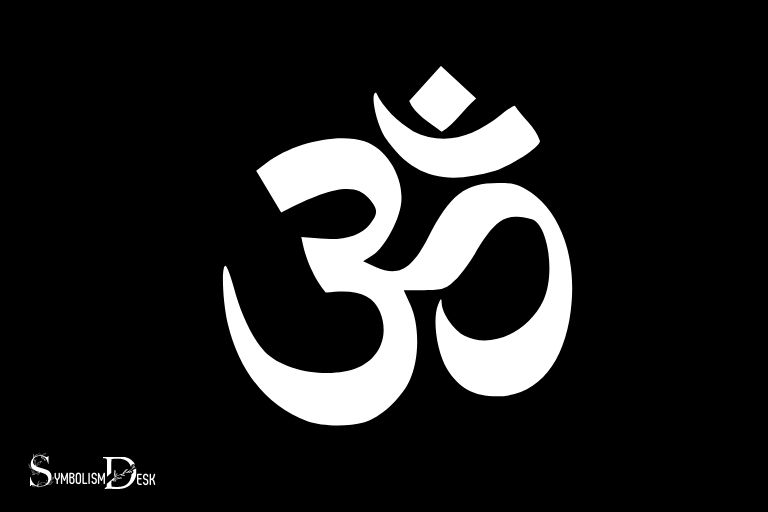What Does the Hinduism Symbol Mean: Sacred Sound!
The Hinduism symbol, also known as the Om or Aum, represents the sacred sound and cosmic vibration that connects all living beings and the universe.
Om (Aum) is considered the most important symbol in Hinduism, as it embodies the essence of the entire universe.
It is believed to be the primordial sound of creation and serves as a powerful mantra in meditation, rituals, and yoga practices.
Om signifies the three stages of existence: creation, preservation, and liberation or destruction.
The Om symbol is often used in art, architecture, and sacred spaces to evoke a sense of unity and cosmic harmony.
Many Hindu rituals and prayers begin and end with the chanting of Om, as it is believed to purify the environment and align the mind with the divine energy.
By meditating on the sound and symbol of Om, practitioners can experience a deeper connection to the universe and their own spiritual nature.
8 Interpretation of Hinduism Symbol Meanings
| Symbol | Name | Meaning |
|---|---|---|
| ॐ | Om or Aum | Represents the sound of the universe, creation, and the energy of life; symbolizes the connection between all living beings. |
| Swastika | Swastika | Represents prosperity, good luck, and the four Vedas (Hindu scriptures). Also symbolizes the four arms of Lord Krishna, Vishnu’s avatar. |
| Lotus | Lotus | Symbolizes purity, beauty, and spiritual awakening; represents rebirth, as the flower grows from muddy waters to bloom. |
| Shiva Lingam | Shiva Lingam | Represents the formless aspect of Lord Shiva; symbolizes the creative power, cosmic energy, and fertility in Hinduism. |
| Trishul | Trishul (Trident) | Symbolizes the power and authority of Lord Shiva; represents the three essences of creation: creation, preservation, and destruction. |
| Tilak | Tilak | A mark worn on the forehead, symbolizing prayer and meditation; represents the third eye of spiritual sight in Hinduism. |
| Conch Shell | Shankha | Represents the sound of creation and cosmic energy; used in religious rituals and ceremonies to ward off evil spirits. |
| Ganesha | Ganesha | Represents wisdom, prosperity, and success; the remover of obstacles in Hinduism. |
Key Takeaway

Five Facts About: The Meaning of Hinduism Symbol
What Is Hinduism Symbol?
The hinduism symbol, also known as ‘om,’ is a popular icon in the indian cultural landscape.
While it may seem like a simple symbol at first glance, the om holds a deep spiritual significance that makes it a revered icon in hinduism.
In this section, we will explore what the hinduism symbol signifies, its history, and how it is used in the modern world.
Introduction To Hinduism Symbol – Om
Om is one of the most recognized and widely used symbols in indian culture. It is a sacred sound and a spiritual icon that signifies the essence of the ultimate reality, consciousness or atman.
Om is considered the primal sound from which the universe was created, and it is believed to have a powerful vibration that can awaken the spiritual self.
History Of The Hinduism Symbol
The term ‘om’ originated from the ancient sanskrit language, and it is mentioned in several hindu scriptures, including the upanishads and the bhagavad-gita.
The om symbol was first used in the hindu tantras and was later adopted by other religions like buddhism and jainism.
The three sounds of om (a-u-m) are said to represent three states of consciousness, namely the waking state, dreaming state, and deep sleep state. Om also represents the three hindu deities- brahma, vishnu, and shiva.
How The Hinduism Symbol Is Used
Om is used in various ways in hinduism.
- Chanting: Reciting or chanting om is an essential part of hindu religious practices. It is believed that chanting om improves concentration and helps in attaining inner peace.
- Yoga: Om is used in various yoga practices. Yoga instructors often start and end their sessions with chanting om to create a meditative state.
- Meditation: Om chanting is also used in meditation practices to improve focus and induce relaxation.
- Tattoos and jewellery: Om tattoos and jewellery are popular among hindus and non-hindus alike.
- Home decor: Om wall hangings, paintings, and sculptures are a common sight in many hindu households. The symbol is used to create a peaceful ambiance and positive energy in homes.
Om is a sacred symbol that holds significant spiritual value in hinduism.
From religious practices to home decor and jewellery, the symbol is used in various ways in modern times while maintaining its ancient cultural significance.
The Meaning Behind The Hinduism Symbol: Om
Hinduism is an ancient religion that believes in the divine force that governs the universe and everything within. One of the most significant symbols of hinduism is the om, which is considered the primal sound of the universe.
The symbol represents the essence of hinduism and all that it stands for.
In this blog post, we will explore the importance of om in hinduism and its spiritual meaning.
Importance Of Om In Hinduism
- Om is considered the most sacred sound in hinduism that represents the ultimate reality and consciousness of the universe.
- The symbol is believed to be the sound of creation, which originated at the beginning of time.
- It is chanted during religious ceremonies and meditation practices as a way to connect with the divine and purify the mind and body.
- The repetition of om is said to help individuals achieve a state of inner peace and tranquillity, leading to a deeper understanding of oneself and the world.
The Spiritual Meaning Of Om
- The sound of om consists of three syllables that represent the different states of consciousness. ‘a’ represents wakefulness, ‘u’ represents the dream state, and ‘m’ represents deep sleep. The silence that follows after chanting om represents the state of pure consciousness, where the individual realizes the true nature of reality.
- The three syllables also represent the different deities in hinduism. ‘a’ represents brahma, the creator of the universe, ‘u’ represents vishnu, the preserver, and ‘m’ represents shiva, the destroyer. The combination of these three represents the unity of all three gods and the cycle of creation, preservation, and destruction.
Om As A Representation Of The Divine
- Om is not just a symbol or sound; it is a manifestation of the divine force that governs the universe.
- The symbol represents the ultimate reality or brahman, which is the source of all existence and consciousness.
- It also signifies the relationship between the individual self or atman and the universal self or brahman. The chanting of om helps individuals realize this connection and achieve a state of enlightenment.
Om is not just a symbol; it is a powerful tool for connecting with the divine and achieving a higher state of consciousness.
It is a representation of the essence of hinduism and all that it stands for: the unity of all things, the cycle of creation, preservation, and destruction, and the ultimate reality of brahman.
The Significance Of The Hinduism Symbol: Om In Daily Life
Om is the most sacred sound in hinduism, and it is considered the essence of the universe. Om is believed to represent the hindu trimurti, consisting of brahma, vishnu, and shiva.
Hindus believe that chanting om can bring spiritual energy to the individual and have numerous benefits.
In this blog post, we explore the various uses of om in hindu rituals, yoga, and meditation practices, as well as how om relates to personal growth and self-realization.
The Various Uses Of Om In Hindu Rituals:
- Om is the first sound recited before any hindu ritual or ceremony begins.
- The symbol is often inscribed on the top of hindu temples, and it is believed to bring you closer to the divine.
- Mantras often contain om, especially in the beginning and end, and they are chanted to bring peace and harmony to the practitioner.
- In hindu weddings, the bride and groom recite om before they take their vows, signifying the beginning of a spiritual journey together.
Om In Yoga And Meditation Practices:
- In yoga, om is often recited at the beginning and end of each practice, as it helps the practitioner focus and ground themselves.
- Om is also a common mantra used in meditation, and practitioners often chant it to enter a deeper state of relaxation and spiritual connection.
- Chanting om is believed to stimulate the chakras, helping to balance energy and enhance overall wellbeing.
How Om Relates To Personal Growth And Self-Realization:
- Om is believed to symbolize the unification of body, mind, and spirit, and chanting it can help practitioners connect to their inner being.
- The sound of om represents the universe’s movement and existing in harmony, thereby invoking a sense of unity and oneness with all beings.
- Practicing spiritual activities such as meditation and yoga can help individuals understand their true nature, and ultimately, lead to self-realization.
The hinduism symbol om has numerous significant uses in daily life, including in hindu rituals, yoga, and meditation practices.
The chanting of this single syllable is considered sacred and can bring spiritual energy to the individual.
By chanting om and practicing yoga and meditation, individuals can connect with their inner being, achieve greater harmony, and ultimately self-realization.
Understanding The Hinduism Symbol: Om Across Different Cultures
The hinduism symbol, om, is a widely recognized spiritual icon, representing the ultimate reality.
It holds immense significance for hindus, and as an seo friendly content writer, in this section, we will explore the significance of om in different cultures.
The Significance Of Om In Buddhist Culture
Om is equally important in buddhist culture, where it represents purity of body, speech, and mind, just like in hinduism. The word om, as pronounced in buddhism, is believed to have the power to purify negative karma and remove sins.
The usage of this symbol can be found in various prayers, chants, and mantras.
Following is an overview of other aspects of om in buddhism:
- It appears at the beginning and end of most buddhist texts
- Om is chanted three times before and after sitting meditation
- The symbol is also used for invoking buddha’s attention
Om In Jainism And Sikhism
In jainism, om is known as the navakar mantra, meaning nine sacred words. It symbolizes the nine essential virtues that are present in all living beings.
Om is believed to be the fundamental sound that vibrates through the universe.
Om is chanted to offer prayers to arihantas, the jain prophets; the tirthankaras, the spiritual guides; and the siddha, the liberated souls.
Sikhism also incorporates om as a sacred symbol. In the sikh religion, om is an acronym of omkaar, meaning god, the primal sound.
Sikhs believe that om resonates in all of life’s creation, and by chanting it, they can connect with the divine energy of waheguru.
Om In Non-Indian Cultures And Religions
The significance of om is not limited to indian religions only. Over the years, the symbol has gained prominence in various cultures worldwide.
Following are some examples:
- In the chinese culture, the symbol of om (aum) is incorporated in calligraphy, where it is regarded as a symbol of clarity.
- In the muslim religion, om is believed to mean “ameen,” which is a sacred word used for confirming the truth of a statement.
- In the judaic tradition, om is also called the ‘ineffable name of god.’ it is associated with the bible’s representation of god as “i am,” emphasizing the eternal, self-existing creator.
- In western new age spirituality, om is known as the ‘sound of the universe.’ it is believed to vibrate at the highest frequency and is often used for meditation and healing purposes.
Om is not just a symbol; it is a way of life, an art, and a science that provides an understanding of the ultimate reality. By exploring om across different cultures, we can uncover its unifying and enlightening power that transcends all boundaries.
The Role Of Om In Modern Society
Om, also known as aum, is a sacred hinduism symbol that holds enormous cultural, philosophical, and religious significance.
Today, its relevance extends far beyond hinduism, with the symbol being adopted and adapted by numerous popular cultures. The following are ways in which om is being used in modern society.
Popular Culture And The Appropriation Of Om
- Om has become a trendy symbol in pop culture. You’ll often spot it on clothing, jewelry, wall art, and even tattoos.
- The appropriation of om has roused controversy as some view it as disrespectful to hinduism, while others see it as a sign of appreciation.
- Famous celebrities like selena gomez, miley cyrus, and rihanna have all been seen sporting om tattoos, further demonstrating its popularity in western pop culture.
The Use Of Om Outside Of Hinduism
- The symbol is widely used in buddhism, jainism, and sikhism, indicating its universal spiritual significance.
- Om has been linked to various healing practices like yoga, meditation, and sound therapy, with the sound, vibrations and the visual representation of the symbol is believed to have powerful effects on the human body, mind, and soul.
- You may find om used in various applications such as mandalas, jewelry, and wall art, in alternative spiritual practices like wicca, druidism, and paganism.
The Relevance Of Om In A Globalized World
- Om unifies people across nationalities, ethnic groups and religions, especially in a world that’s becoming more interconnected.
- Om is an invitation to be mindful, to practice compassion, and to rediscover a peaceful state of mind. Hence it holds even more relevance and significance in this anxiety-ridden and digitally connected world.
- Om is a symbol of the divine, holy, and perfect nature of the universe, reminding us to be aware of ourselves and the world around us, encouraging us to live a life of gratefulness, respect, and reverence.
While om originated from hinduism, its enormous cultural, philosophical, and religious significance has seen it become widely used outside of the religion in modern society.
The symbol serves a crucial role in promoting mindfulness, unity, and peace in a globalized world.
What are the Meanings Behind Reiki Symbols and Hinduism Symbols?
Reiki symbols sacred meanings hold significant importance in both Reiki and Hinduism. Reiki symbols like Cho Ku Rei symbolize the power to focus energy, while Hinduism symbols like Om represent the ultimate reality. These symbols serve as powerful tools to access spiritual energies, enhance healing practices, and deepen our connection with divine consciousness.
FAQ About The Hinduism Symbol Mean
What Is The Hinduism Symbol Called?
The hinduism symbol is called om or aum.
What Does The Hinduism Symbol Represent?
The hinduism symbol represents the sound of the universe, consciousness, and the three major hindu gods.
What Is The Significance Of The Hinduism Symbol?
The hinduism symbol signifies the essence of hinduism, the ultimate reality, and the unity of everything in the universe.
What Are The Different Meanings Of The Hinduism Symbol?
The hinduism symbol has different meanings including the past, present, and future; creation, preservation, and destruction; waking, dreaming, and sleeping states.
How Do Hindus Use The Hinduism Symbol In Their Worship?
Hindus use the hinduism symbol in their worship by chanting it, wearing it as a symbol of protection, and using it as a meditation tool.
Conclusion
From what we’ve uncovered, it is clear that the hinduism symbol has significant depth and meaning. The om sound and its expansive representation are central to the practice of hinduism and have immense spiritual value.
Its symbols and rituals mirror hinduism’s diverse and complex philosophy, which emphasizes the interconnectedness of all things and beings in the universe.
The study of this incredible religion continues to be fascinating. Whether it’s learning its beliefs, symbolism, or culture, the journey of knowledge is always rewarding.
We hope that this post has provided you with valuable information about the hinduism symbol.
In the end, understanding its history and symbolism is crucial to appreciating the essence of hinduism, and we encourage people to continue exploring its rich traditions and practices.






